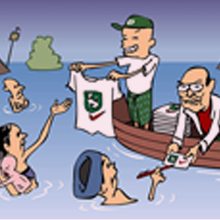
La censura es algo inherente a la vida del humor, ya que el poder no congenia con la libertad de opinión. El encarcelamiento, la tortura y la muerte no deberían serlo, porque son degradantes para cualquier sociedad llamada civilizada. Los países que hacen todo esto a sus ciudadanos más irreverentes lamentablemente abundan en este planeta y Myanmar es un extraño ejemplo porque tiene una enorme industria del humor gráfico (con unos 200 miembros de la Asociación de Dibujantes), al mismo tiempo que es una de los países que más encarcelan y torturan ya veces incluso matan a sus artistas. Traté de contactar a varios de estos artistas, pero ninguno respondió. ¿Porque el internet está cortado, vigilado? ¿Por miedo a las represalias?
Myanmar, o Birmania como se la conocía antiguamente, nos resulta familiar por la película «Un puente sobre el río Kuay», un punto geográficamente lejano, dominado por los británicos, luego por los japoneses, hasta conseguir finalmente su independencia. También es bien conocido por su violencia budista, contra sus políticos (la destacada Premio Nobel de la Paz Aung San Suu Kyi, ama de casa durante décadas), contra los musulmanes roningya, contra todo lo que inspira desacuerdo con el poder militar, todo lo que huele a democracia.
En el campo del caricaturista, todo empezó con el Imperio Británico y su política de britanizar las costumbres locales, sin embargo, cada pueblo ya tenía su sentido del humor, independientemente de las influencias occidentales, pero no siempre fue fácil mantener ese carácter local. Curiosamente, en aquellos tiempos coloniales los caricaturistas ingleses que publicaban allí sus obras preferían usar seudónimos, solo Martin Jones daría el rostro a sus creaciones. Sería él, junto a otros británicos, quienes abrirían la primera escuela de arte donde saldrían los primeros dibujantes birmanos, como U Ba Gale (Shwetalay) (1915), U Ba Gyan, U Hein Sunn a partir de los años 90, que es decir, más de cien años. No fue fácil evangelizar a la sociedad birmana a este tipo de arte alegórico y deformante, por lo que en las primeras décadas cada dibujo debía ir acompañado de largos textos explicativos. Quizás esa sea la razón del éxito de la historieta, la rama que financia la supervivencia económica de la mayoría de los dibujantes. Otra forma de supervivencia hoy en día es también el cine y la animación.
Curiosamente, o no, durante el dominio británico, a pesar de alguna quesilia judicial, la libertad de expresión de los lugareños era amplia, libertad que luego desapareció a partir del momento en que fueron ellos quienes se gobernaron a sí mismos a partir de 1948. En 1962 tuvo lugar el primer golpe militar dictatorial y desde entonces la libertad de expresión ha sido algo tenue, a menudo ocupando celdas, campos de concentración del régimen.
¿Nombres importantes en la caricatura en Nyanmar? U Tin Aung Ne esencialmente se gana la vida como dibujante de historietas, pero incluso ese arte está en peligro: «Si el hábito de la lectura desaparece, los niños serán débiles en cuanto a moralidad y creación artística en el futuro».
U Myint Htay (más conocido como U Poe Zar): «La contribución económica de los dibujos animados no es suficiente para mantener a una familia y la situación empeora cada vez más porque las creaciones de los dibujantes están cada vez más controladas por la política del gobierno. Esto asfixia el desarrollo de una nueva generación de dibujantes».
Win Maung, que contrata a Maung Khit Htun, dice: «Tengo que desempeñar los roles de escritor, traductor, editor y editor de mis caricaturas para sobrevivir. La mayoría de los dibujantes abandonaron el dibujo y se convirtieron en simples periodistas».
Maung Maung Aung: «Los dibujos de humor necesitan libertad. Cuanta más libertad hay, más un dibujo es capaz de decir y ser creativo, para que pueda tener más sentido». Este artista ya conoció la experiencia de la emigración, pero recientemente regresó.
Chit Swe ya ha sido culpable de «desafiar las órdenes de las autoridades» por su diseño, por lo que ya conoció las prisiones de su país.
Win Naing (cuyo seudónimo es Aw Pi Kyeh).
Myanmar Htein Lin es quizás el dibujante que ha pasado más tiempo en prisión: 1991, 1998, 2000... (con mucha tortura: descargas eléctricas, palizas, quemaduras con cuchillos calientes...).
Maung Maung Fountain (seudónimo), U Ba Kyi, Pe Thein, U Kyaw San, U Aung Shein...
Pero no sólo de cartoonismo vive el humor encarcelado, ya que hay una larga historia de humor teatral en tierras de Birmania. Zarganar (seudónimo de Maung Thura) será el comediante, en el universo que hoy se llama stand up comedy, que más tiempo haya pasado en prisión (11 años). «Veía programas de televisión en Estados Unidos y un amigo me mostró Stephen Colbert. Hizo muchas bromas sobre el gobierno, y puede hacerlo porque la constitución lo protege y permite la libertad de expresión. Si hiciera este tipo de bromas en mi país, definitivamente me enviarían a prisión. Esto no quiere decir que la sátira no exista en Birmania, por el contrario, es quizás un poco más sutil, particularmente sobre la corrupción... Aquí tenemos que tener mucho tacto. A veces los chistes no son divertidos de inmediato, a veces no entiendes el chiste hasta más tarde».
Zarganar ha sido arrestado varias veces desde 1988 y si tuviera que cumplir el total de las condenas serían más de 60 años en cautiverio: «Cada vez que me arrestaron, pensé que todas las puertas se abrían a dos formas, hacia adentro y hacia afuera, y algún día saldré seguro. Siempre mantuve el sentido del humor y eso me ayudó a sobrevivir en un confinamiento solitario durante cuatro o cinco años. Una de las herramientas fue escribir canciones mientras estaba en prisión. No tenía papel o lápices, así que los escribí en mi cabeza y en mi corazón. Escribí poemas y guiones, y a veces usaba una banda elástica como cuerda y la tocaba para hacer música. En realidad, no tengo experiencia con instrumentos musicales, pero cuando salí de la cárcel pude leer música, gracias a esa goma, aproveché ese tiempo para entrenar mi mente y mantuve mi sentido del humor a la par de este trabajo».
Más trágica es la ruta que a U Par Par Lay le encantaba contar el chiste: «U Par Par Lay va a India para tratar su dolor de muelas. El dentista indio se pregunta por qué vino un birmano a la India. “¿No tienen dentistas en Myanmar?” “Oh, sí, lo hacemos, doc. Pero en Myanmar, no podemos abrir la boca». Nunca dejó de hablar y desapareció en las brumas de la opresión, después de varios períodos efímeros anteriores en la prisión estatal.
U Par Par Lay era el líder de una compañía de «A-nyeint Pwe», vodevil tradicional de Myanmar, que presentaba títeres, música y comedia teñida de sátira política directa. En la antigüedad, los reyes birmanos usaban las actuaciones de A-nyeint Pwe para medir el sentimiento público expresado en la comedia.
La compañía de Par Par Lay solía viajar de pueblo en pueblo, actuando en bodas, funerales y festivales, así como también en el rosario instalado en su casa en Mandalay. El resto del grupo sigue trabajando y como dice su esposa: «Si viene el gobierno y le quita la ropa y la comida, entonces sabré que está vivo. Tal vez esté actuando en algún lugar de la prisión, como solía hacerlo cuando lo arrestaron anteriormente... Sí, tenemos miedo. Pero seguimos riéndonos. Solo hacemos comedia. Este es nuestro trabajo, nuestra tradición familiar».
Mundo de los Humores – La Dictadura del humor
La frase «te quiero» es la expresión menos cómica de la humanidad, pero comparte el mismo espíritu de humor incondicional, siendo ambos hijos de la felicidad, por eso la mayor parte del tiempo van juntos, por eso, cuando los enfermos se ponen divorciados, se mudan y se destruyen a sí mismos.
Nosotros, que luchamos por contagiar sonrisas, en una sociedad que favorece el drama y la tragedia, nos sorprendemos cuando escuchamos a pensadores que dicen que hoy vivimos bajo la dictadura del humor. ¿Será verdad? ¿O es más la dictadura del comico en ese entretenimiento alucinógeno obligatorio que nos vuelve anodinos, en una sociedad controlada por los medios, títeres de poderes ocultos?
Si hoy todo se llama humor y comediantes, hay que diferenciar el remedio del veneno y leer el prospecto de contraindicaciones. La era posmodernista, o también defendida como la era del vacío (ideológica, ético-economicista), es una era de ligereza de pensamiento, de analfabetismo cultural y mental simbolizada por líderes políticos como Trump, Bolsonaro... por la elevación de las individualidades de entretenimiento. a los más altos cargos políticos como los estadounidenses Donald Reagen (Presidente), Arnold Schwarzenegger (Gobernador), el ucraniano Volodymyr Zelensky (Presidente)... o incluso payasos y cómicos. El primero sería el francés Coluche que se postuló a presidente de la República, mientras que en Italia Beppe Grillo creó un partido y fue elegido diputado, como lo fue el senador brasileño Tiririca o el esloveno Marjan Sarec cuando llegó a primer ministro... Cuando el humor sube al poder , se pudre, porque ya no tiene distancia crítica, subyugado a LOLs (Laughing Out Loud). Es que el lado violador del humor es también su talón de Aquiles.
La gente dice: «mucha risa, poca sabiduría» y, como todos sabemos, lo que es medicina, si se exagera, se convierte en veneno. ¿La risa mata? ¿La risa oprime? ¿Puede ser dictatorial? Todos somos conscientes de que el humor, por sí solo, no cambia el mundo, solo lo mejora temporalmente, lo hace momentáneamente más llevadero, incidiendo en que la humanidad sea más consciente en compartir sonrisas y optimismo.
Sin embargo, este poder del humorista, que no mata pero puede transformar, como todos los poderes, si se abusa, puede ser dañino y venenoso. Este cómic que puede insultar, denigrar, humillar... puede ir seguido de: "¡¡¡Pues eso no lo sabía!!!" pero esta grotesca afirmación transita en el tiempo de la luz en los circuitos sociales de manera imparable con millones de Likes, instalándose como verdades imborrables. Así, si logras distraer a la población, controlas el mensaje que quieres difundir en este universo de títeres que solo quieren aparecer momentáneamente en la gloria del chiste existencial.
Demasiados chistes matan el chiste y la corrección política nos lleva a la locura cómica, es decir al absurdo, haciendo reír al no-mensaje, envuelto en el nihilismo carnavalesco planetario. Hay un miedo generalizado al silencio, porque tememos estar cara a cara con nosotros mismos y la risa intrascendente distrae de este miedo, construyendo una falsa escenografía de bienestar, sin desarrollar los verdaderos beneficios terapéuticos del humor/amor.
¿Realmente tenemos que ser graciosos, o debemos saber detenernos, pensar y, a veces, llorar con humor? Riendo o sonriendo, lo importante es ser inteligente, tolerante y filosófico. ¡Abajo cualquier dictadura!
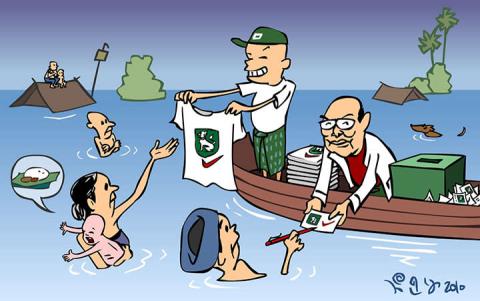
Aw Pi Kew

Kaung Htet San
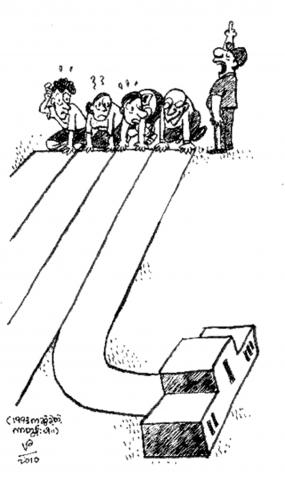
Aw Pi Kyeh
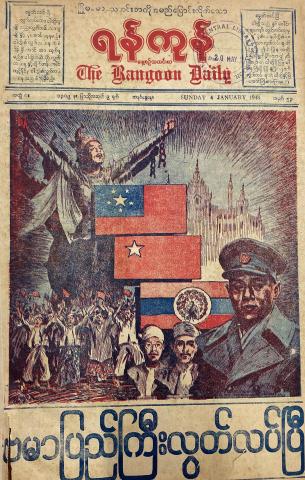
4th_of_january_1948_-_the_rangoon_daily
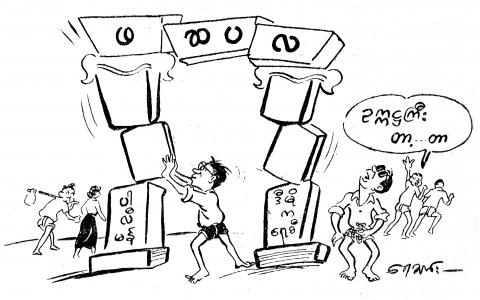
9th_july_1962_-_botahtaung_the_vangaurd_daily

ba-gyan-cartoon-1
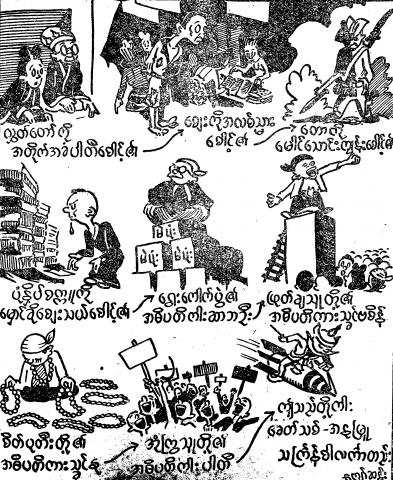
4th_april_1951_-_the_rangoon_daily
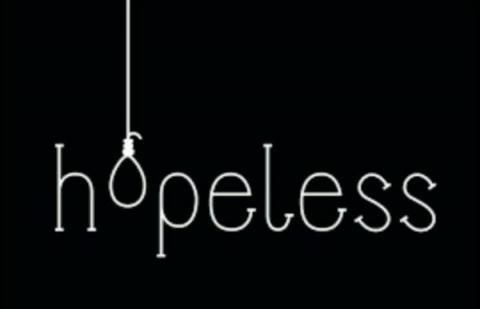
Kaung Htet San 2
Humors of the World – Myanmar
Censorship is something inherent in the life of humor, since power does not get along with freedom of opinion. Imprisonment, torture and death should not be, because they are demeaning to any so-called civilized society. Countries that do all this to their most irreverent citizens unfortunately abound on this planet and Myanmar is a strange example because it has a huge graphic humor industry (with about 200 members of the Association of Cartoonists), at the same time that it is one of the countries that most imprisons and tortures and sometimes even kills its artists. I tried contacting several of these artists, but none responded. Because the internet is cut off, watched? For fear of reprisals?
Myanmar, or Burma as it was formerly known, is familiar to us from the film «A bridge over the river Kuay», a geographically distant point, dominated by the British, then the Japanese, until finally achieving its independence. It is also well known for its Buddhist violence, against its politicians (noted Nobel Peace Prize winner Aung San Suu Kyi, housewife for decades), against Roningya Muslims, against everything that inspires disagreement with military power, everything that it smells like democracy.
In the field of cartoonism, everything started with the British Empire and its policy of Britishizing local customs, however, each people already had their sense of humor, regardless of western influences, but it was not always easy to maintain that local character. Interestingly, in those colonial times the English cartoonists who published works there preferred to use pseudonyms, only Martin Jones would give the face to their creations. It would be him, with other Britons, who would open the first art school where the first Burmese cartoonists would come out, such as U Ba Gale (Shwetalay) (1915), U Ba Gyan, U Hein Sunn from the 1990s onwards, that is, more of a hundred years. It was not easy to evangelize Burmese society to this kind of deforming, allegorical art, which is why in the first decades each drawing had to be accompanied by long explanatory texts. Perhaps that is the reason for the success of comics, the branch that finances the economic survival of most cartoonists. Another form of survival today is also cinema and animation.
Interestingly, or not, during British rule, despite one or another judicial quesilia, the freedom of expression of the locals was vast, a freedom that later disappeared from the moment when they were the ones to govern themselves from 1948 onwards. In 1962, the first dictatorial military coup took place and since then freedom of expression has been somewhat tenuous, often occupying cells, the regime's concentration camps.
Important names in cartooning in Nyanmar? U Tin Aung Ne essentially earns his living as a comic artist, but even that art is in danger - «If the habit of reading disappears, children will be weak in morality and artistic creation in the future».
U Myint Htay (better known as U Poe Zar): «The economic contribution of cartoons is not enough to support a family and the situation gets worse and worse because cartoonists' creations are more and more controlled by government policy. This suffocates the development of a new generation of cartoonists».
Win Maung, who signs Maung Khit Htun says: «I have to play the roles of writer, translator, editor and publisher of my cartoons to survive. Most cartoonists abandoned drawing and became simple journalists».
Maung Maung Aung: «Cartoons need freedom. The more freedom there is, the more a drawing is able to say and be creative, so that it can have more meaning». This artist has already known the experience of emigration, but recently returned.
Chit Swe has already been guilty of «defying the orders of the authorities» for his design, so he has already met the prisons of his country.
Win Naing (whose pseudonym is Aw Pi Kyeh).
Myanmar Htein Lin is perhaps the cartoonist who has spent the longest time in prison: 1991, 1998, 2000... (with a lot of torture: electric shocks, beatings, burns with heated knives...).
Maung Maung Fountain (pseudonym), U Ba Kyi, Pe Thein, U Kyaw San, U Aung Shein...
But not only cartoons live imprisoned humor, as there is a long history of theatrical humor in the lands of Burma. Zarganar (pseudonym of Maung Thura) will be the comedian, in the universe that today is called stand up comedy, who has spent the most time in prison (11 years). «I watched TV programs in the United States and a friend showed me Stephen Colbert. He made a lot of jokes about the government - and he can do it because the constitution protects it and allows free speech. If I made this kind of joke in my country, I would definitely be sent to prison. This is not to say that satire does not exist in Burma - on the contrary, it is perhaps a little more subtle, particularly about corruption... Here we have to be very tactful. Sometimes the jokes aren't funny right away - sometimes you don't understand the joke until later».
Zarganar has been arrested multiple times since 1988 and if he had to serve the total sentences it would be more than 60 years in captivity: «Every time I was arrested, I thought it was that every door opens to two ways, in and out, and one day I'll be released for sure. I always kept a sense of humor and that helped me survive in solitary confinement for four or five years. One of the tools was writing songs while I was in prison. I didn't have paper or pencils, so I wrote them down in my head and in my heart. I wrote poems and scripts, and sometimes I used a rubber band as a string and played it to make music. Actually, I have no experience with musical instruments, but when I got out of prison I could read music, because of that rubber band. I used that time to train my mind and kept my sense of humor going along with this work».
More tragic is the route U Par Par Lay loved to tell the joke: «U Par Par Lay goes to India to treat his toothache. The Indian dentist wonders why a Burmese came to India. “Don't you have dentists in Myanmar?” “Oh, yes, we do, Doc. But in Myanmar, we can't open our mouths.”» He never stopped talking and disappeared into the mists of oppression, after several previous ephemeral stints in the state prison.
U Par Par Lay was the leader of a troupe of «A-nyeint Pwe», traditional Myanmar vaudeville, featuring puppets, music and comedy tinged with straightforward political satire. In ancient times, Burmese kings used the performances of A-nyeint Pwe to gauge the public sentiment expressed in comedy.
Par Par Lay's troupe used to travel from village to village, performing at weddings, funerals and festivals as well as performing in the rosary set up at their home in Mandalay. The rest of the group continues to work and as his wife says: «If the government comes and takes his clothes and food, then I will know that he is alive. Maybe he's acting out in prison somewhere, like he used to when he was previously arrested... Yes, we're scared. But we kept laughing. We just do comedy. This is our work, our family tradition».
World of Humors – The Dictatorship of the Comic
The phrase «I love you» is the least comic expression of humanity, yet it shares the same spirit of unconditional humour, being both children of happiness, which is why most of the time they go together, which is why, when sick people get divorced, they move away and destroy themselves.
We, who struggle to spread smiles, in a society that privileges drama and tragedy, are surprised when we hear thinkers who say that today we live under the dictatorship of humor. Will it be true? Or is it more the dictatorship of the comic in that obligatory hallucinogenic entertainment that makes us anodyne, in a society controlled by the media, puppets of occult powers?
If today everything is called humor and comedians, it is necessary to differentiate the remedy from the poison and read the contraindications leaflet. The postmodernist era, or also defended as the era of emptiness (ideological, ethical-economicist), is an era of lightness of thought, of cultural and mental illiteracy symbolized by political leaders like Trump, Bolsonaro... by the elevation of entertainment individualities to the highest political offices such as the Americans Donald Reagen (President), Arnold Schwarzenegger (Governor), the Ukrainian Volodymyr Zelensky (President)... or even clowns and comics. The first would be the French Coluche who ran for President of the Republic, while in Italy Beppe Grillo created a party and was elected deputy, as was the Brazilian senator Tiririca or the Slovenian Marjan Sarec when he became Prime Minister... When humor rises to power, it rots, because it no longer has critical distance, subjugated to LOLs (Laughing Out Loud). It's just that the violating side of humor is also its Achilles' heel.
The people say: «a lot of laughter, little wisdom» and, as we all know, what is medicine, if exaggerated, becomes poison. Does laughter kill? Laughter oppresses? Can it be dictatorial? We are all aware that humor, in itself, does not change the world, it only temporarily improves it, it makes it momentarily more bearable, influencing humanity to be more conscious in sharing smiles and optimism.
However, this power of the humorist, which does not kill but can transform, like all powers, if abused, can be harmful and poisonous. This comic that can insult, denigrate, humiliate... can be followed by: "Well, I didn't know that!!!" but this grotesque statement travels in the time of light in social circuits in an unstoppable way with millions of Likes, installing itself as truths that cannot be erased. Thus, if you can distract the populace, you control the message that you want to spread in this universe of puppets who only want to appear momentarily in the glory of the existential joke.
Too many jokes kill the joke and political correctness takes us to comic madness, that is to the absurd, making people laugh at the non-message, involved in planetary carnivalesque nihilism. There is a generalized fear of silence, because we fear being face to face with ourselves and inconsequential laughter distracts from this fear, building a false scenography of well-being, without developing the true therapeutic benefits of humor / love.
Do we really have to be funny, or should we know how to stop, think and, sometimes, cry humorously? Laughing or smiling, the important thing is to be intelligent, tolerant and philosophical. Down with any dictatorship!
